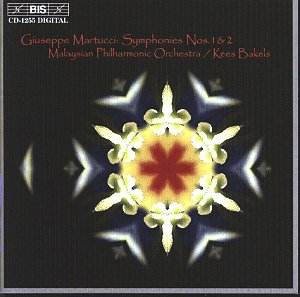Until ASV launched their magnificent series of Martucci
orchestral works, the music of this Italian composer, who preferred
to write in forms other than opera and looked towards composers
of northern Europe for inspiration, remained relatively little
known. The name Martucci was more often associated with his teaching
of Respighi. Alas this new recording cannot match the splendour
of Naples-born Francesco d'Avalos's ASV recordings with the Philharmonia
made (with the production skills of Brian B. Culverhouse) in 1989.
Symphony No. 1 is on ASV CD DCA 675 with Novelletta, Notturno
and Tarantella; No. 2 is available with Andante and Colore Orientale
on ASV CD DCA 689. The BIS recording is an international mix by
the way: a Swedish record company recording an Italian symphony
performed by a Malaysian orchestra conducted by a Dutchman.
It is interesting to compare the booklet notes
for the BIS and ASV releases. They emphasise quite different influences
on Martucci's compositional style. In the BIS booklet, Sibelius
is quoted as being owed a "considerable debt" by Martucci
in his Second Symphony. In the opening movement, Bakels points
up this Sibelian influence too strongly, enforcing a too simplistic
rhythmic structure in comparison with d'Avalos's smoother, more
subtle Sibelius references. He is much more successful in realising
the subtleties of Martucci's continually shifting rhythms. His
reading flows more smoothly and the atmosphere is that much warmer.
Likewise d'Avalos makes the engaging Scherzo a lovely quicksilver
flight of fancy reminding one of the fairy lightness of Mendelssohn's
A Midsummer Night's Dream. In comparison, Bakels' spirits are
a glum lot. The two remaining movements of Martucci's Second Symphony
are less appealing: the Adagio being rather sombre although d'Avalos
succeeds much better than Bakels in pointing up the Southern Italian
bitter-sweetness of the later section. The clever complexity of
the final Allegro, with its marching figures and clipped modulations,
diminishes its appeal and in this instance Bakels scores by driving
it that much harder than d'Avalos.
The First Symphony's influences are basically Beethoven, Schumann
and Brahms. Again, Bakels cannot resist shaping the material so
that the Brahmsian elements are too obvious, particularly in the
marvellous exciting finale. Here d'Avalos puts this influence
into a lesser perspective. His more legato approach is nevertheless
more thrilling (it sounds amazingly like Elgar in nobilmente mode).
Throughout these two symphonies, d'Avalos's warmer (you can feel
the Italian sunshine), smoother, more subtle and flexible readings
seem much shorter than those of Bakels, although reference to
the timings proves, more often than not, that the opposite is
the case. In the opening movement of the First Symphony, D'Avalos
pushes the heroic material strongly forward in an uncharacteristic
quicker reading than that of Bakels who admittedly has an attractive
swagger but it is slowed by Brahmsian caution. D'Avalos's view
of Martucci's glorious Adagio is softer, more romantic and his
Allegretto has more charm and poetry.
Disappointing, stolid performances. Turn to the ASV recordings
with Francesco d'Avalos and the Philharmonia on top form to discover
the considerable beauty and excitement of these glorious, neglected
Martucci symphonies.
Ian Lace

